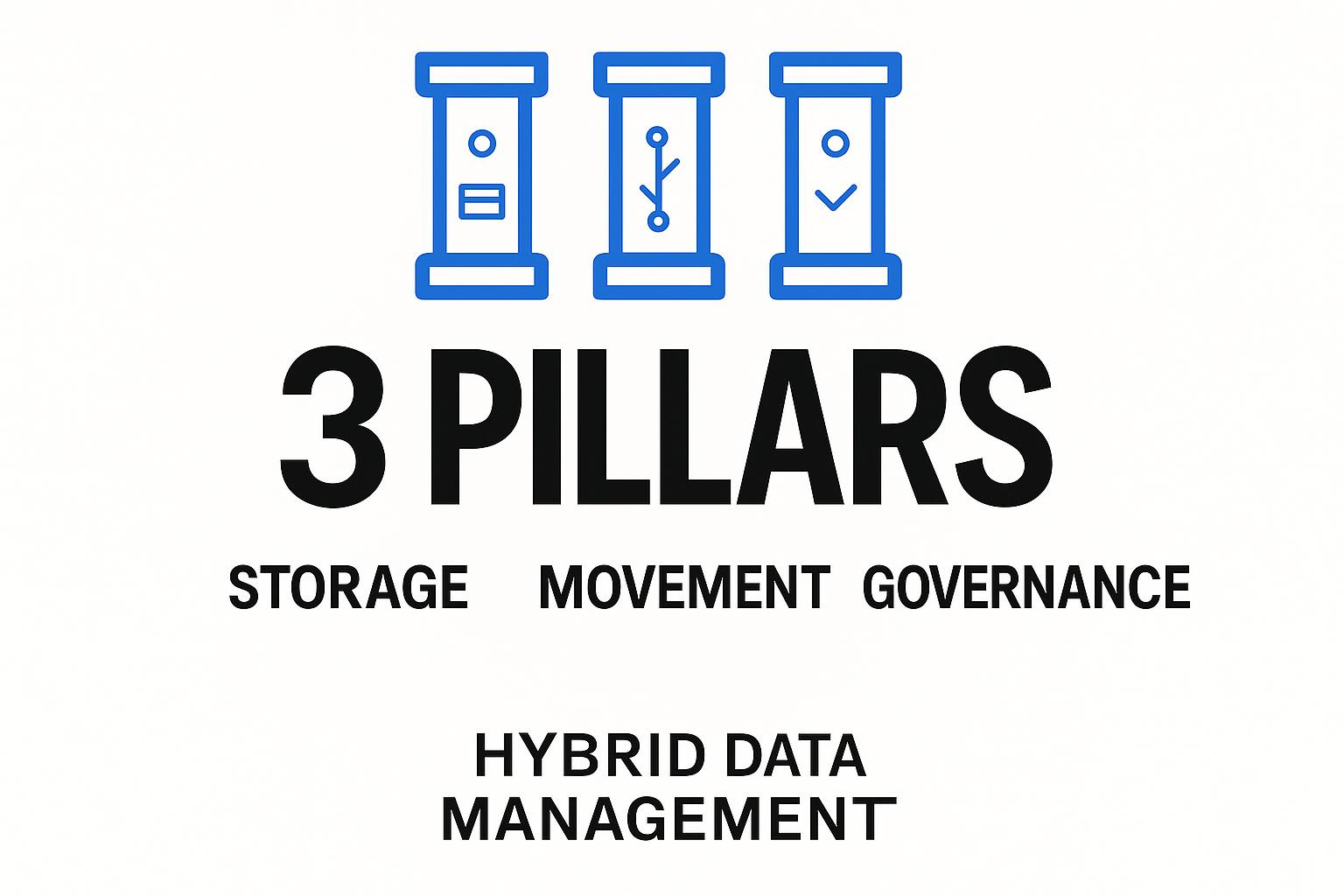What is Hybrid Data Management?
Summarize this article with:
✨ AI Generated Summary
Enterprise data teams operate in an era where compliance frameworks expand faster than infrastructure can adapt. Every new region, vendor, or workload adds complexity, forcing organizations to balance strict residency rules with the need for fast, scalable analytics. The challenge is not the lack of data but the lack of unified control over how and where that data is stored, moved, and governed.
Hybrid data management emerged as a practical solution to this problem. It helps enterprises modernize analytics pipelines, adopt cloud flexibility, and maintain regulatory confidence while keeping data within trusted environments.
What Exactly Is Hybrid Data Management?
Hybrid data management is the coordinated way you store, move, and govern data across on-prem servers, private clouds, and public clouds under one policy framework. Instead of forcing every workload into a single environment, you decide where data physically lives, how it travels, and which rules follow it, without losing visibility or control.

This unified approach rests on three foundational pillars that work together to create seamless data operations:
- Data Storage: choosing the right location for each dataset, from local disks to object stores in the cloud
- Data Movement: replicating or syncing data between environments so it's always where you need it
- Data Governance: enforcing the same security, lineage, and audit policies everywhere
These pillars come to life through several integrated technical layers that span your entire infrastructure.
- The storage layer supports both cloud and on-prem options, handling formats like Parquet or JSON across different environments.
- The metadata layer tracks schemas, versions, and lineage so you can discover data regardless of location, often using table formats like Apache Iceberg for time-travel queries.
- The processing layer runs transformations close to the data to cut latency and cost, while the query and access layer lets analysts issue a single SQL query even when tables live in different locations.
Integration tools automate replication and streaming across environments, working alongside the governance and security layer that applies role-based access, encryption, and audit logging everywhere.
Because these layers share one control surface, you get consistent policies and real-time insight across your entire data estate, no matter where the bytes reside. The result is a unified infrastructure that meets regulatory mandates without slowing down the analytics your team depends on.
How Does Hybrid Data Management Work?
Hybrid data platforms split intelligence from execution through a sophisticated separation of concerns. The control plane (your system's "brain") decides what should happen, while the data plane carries out the actual moves and transformations. Because the control plane never touches raw records, you get centralized orchestration without giving up custody of sensitive data.
The control plane manages scheduling, policy enforcement, user authentication, and health monitoring from a hardened environment, often running as a managed SaaS tier. It communicates with every data-plane node through outbound-only connections, a pattern that keeps firewalls closed to unsolicited traffic and narrows the attack surface considerably.
Each data-plane instance executes the actual work across different environments (whether in a private cloud, factory floor server, or regulated on-prem cluster) by extracting rows, applying transforms, and writing results. This architectural separation makes it easy to plug in secret managers, audit logging, and compliance scanners without rewriting existing pipelines.
This separation delivers practical advantages that compound over time. Sensitive rows never leave the data plane, so you meet residency and sovereignty rules without extra tooling. Operators manage every environment from a single console, trimming operational overhead significantly. And because the control plane is insulated from production datasets, a breach there can't expose customer information, which materially reduces risk.
The architecture works by letting you think globally (one place to set policies) while acting locally (running jobs exactly where the data lives).
What Are the Benefits of Hybrid Data Management?
Hybrid architectures deliver measurable operational advantages when you need to balance regulatory requirements with modern data capabilities. The following six benefits justify the architectural investment and ongoing operational complexity.
1. Compliance Without Compromise
You can satisfy data residency requirements by keeping sensitive records on-premises while moving analytics workloads to the cloud. Patient data stays within HIPAA-compliant infrastructure, while anonymized datasets feed cloud-based machine learning models. This approach meets GDPR territorial requirements without sacrificing analytical capabilities.
2. Unified Governance Across Environments
You eliminate the need to manage separate policy engines. Apply consistent access controls, cataloging, and lineage tracking regardless of where data resides. Role-based permissions travel with the data, creating audit trails that span your entire infrastructure and simplify compliance reporting.
3. Dynamic Resource Allocation
You can scale analytics workloads into cloud compute during peak periods, then pull them back when demand drops. Core, latency-sensitive operations stay close to users on-premises while variable workloads use elastic cloud resources, optimizing both performance and cost.
4. Optimized Infrastructure Costs
You rent additional compute and storage only when needed rather than over-provisioning on-premises hardware for peak loads. Shift non-critical storage to lower-cost cloud tiers while maintaining high-performance local access for production systems.
5. Operational Flexibility
You can run ERP upgrades in isolated cloud environments while production systems continue operating on-premises. Development and testing environments can mirror production without exposing sensitive data or impacting operational systems, accelerating release cycles.
6. Enhanced Business Continuity
You maintain active data replication across environments, creating recovery options when regional outages affect a single provider. Two operational paths keep pipelines running even when one environment experiences disruption, reducing downtime and business impact.
These benefits compound when implemented systematically rather than as isolated point solutions, creating a foundation for long-term data strategy evolution.
Who Needs Hybrid Data Management Most?
The following industries face the most acute challenges that hybrid architectures specifically address:
If you operate in any environment where regulations are tightening, workloads spike unpredictably, or data must travel thousands of miles yet remain under strict control, you're already in hybrid territory, even if your tooling hasn't caught up yet. Modern data management is quickly becoming the default operating model for any organization that values both control and innovation.
Why Airbyte Enterprise Flex Is Built for Hybrid Data Management?

When you oversee data that lives partly in the cloud and partly in your own racks, the hardest part is keeping control without adding more tools. Airbyte Enterprise Flex solves that challenge by splitting the work: a SaaS control plane sets policies and monitoring, while a customer-hosted data plane moves the bytes. Because the control plane never touches raw data, you maintain sovereignty while still operating from one pane of glass.
Key advantages of Airbyte Flex for hybrid data management:
- Identical architecture everywhere: The same codebase covers VPC, bare metal, or multi-cloud deployments, so you never trade features for compliance
- Minimal attack surface: Outbound-only connections from data plane to control plane mean no open ingress ports
- Automatic compliance: Sensitive tables never leave your environment, meeting GDPR, HIPAA, or regional residency rules by design
- Centralized operations: Scheduling, lineage, and alerting run centrally, so you tune one job instead of managing three separate clusters
- Rapid deployment: Most teams stand up pipelines in days rather than months, thanks to Docker- or Kubernetes-based installers that work consistently across environments
- No vendor lock-in: The world's largest open connector catalog (600+ connectors) works unchanged across cloud, on-prem, and distributed installs
- Enterprise-grade security: Carries SOC 2, ISO 27001, and HIPAA alignment, plus role-based access control and detailed audit logs exposed through the control plane UI
- Proven at scale: Customer deployments already move multiple petabytes each day without throttling, proving the design scales long after the first sync completes
This design ensures sensitive tables never leave your environment, meeting GDPR, HIPAA, or regional residency rules automatically. Scheduling, lineage, and alerting run centrally, so you tune one job instead of managing three separate clusters. Most teams stand up pipelines in days rather than months, thanks to Docker- or Kubernetes-based installers that work consistently across environments.
The world's largest open connector catalog (600+ connectors) works unchanged across cloud, on-prem, and distributed installs, giving you maximum flexibility without vendor lock-in. Flex carries the security certifications enterprises expect, including SOC 2, ISO 27001, and HIPAA alignment, plus role-based access control and detailed audit logs exposed through the control plane UI.
In production environments, customer deployments already move multiple petabytes each day without throttling, proving the design scales long after the first sync completes.
How Can You Get Started With Hybrid Data Management?
Modern data management requires the granular control of on-premises infrastructure combined with cloud resources for scale, compliance, and near-real-time analytics without sacrificing performance. Organizations that embrace this distributed approach gain competitive advantages through faster insights, lower costs, and simplified compliance across complex regulatory environments.
The architectural patterns we've explored are proven solutions already moving petabytes of data daily for enterprises across financial services, healthcare, manufacturing, and telecommunications. As data volumes grow and regulations tighten, these patterns become essential for maintaining both operational control and analytical innovation.
Airbyte Enterprise Flex delivers 600+ connectors with unified AI-ready quality across cloud, hybrid, and on-premises with no feature trade-offs or vendor lock-in.
Talk to Sales about your hybrid data management requirements.
Frequently Asked Questions
What's the Difference Between Hybrid Data Management and Multi-Cloud?
Hybrid data management coordinates data across on-premises and cloud environments under unified policies, while multi-cloud specifically refers to using multiple cloud providers. Hybrid architectures can include multi-cloud elements but emphasize the integration between private infrastructure and cloud services rather than just cloud-to-cloud coordination.
How Does Hybrid Data Management Impact Data Latency?
Hybrid architectures can reduce latency by processing data close to its source (keeping time-sensitive operations on-premises while pushing analytics workloads to the cloud). The key is strategically placing compute resources near the data that needs processing, using the control plane to orchestrate without introducing network hops for sensitive operations.
What Security Certifications Should I Look for in Hybrid Data Management Tools?
Look for SOC 2 Type II, ISO 27001, and industry-specific certifications like HIPAA (healthcare), PCI DSS (financial services), or FedRAMP (government). These certifications demonstrate that the vendor has implemented enterprise-grade security controls across both control plane and data plane components.
Can Hybrid Data Management Work With Existing ETL Tools?
Yes, hybrid data management platforms typically integrate with existing orchestration tools like Airflow, Prefect, and Dagster, as well as transformation tools like dbt. The goal is to enhance rather than replace your current data stack, providing the hybrid deployment flexibility and governance capabilities your existing tools may lack.

.webp)
